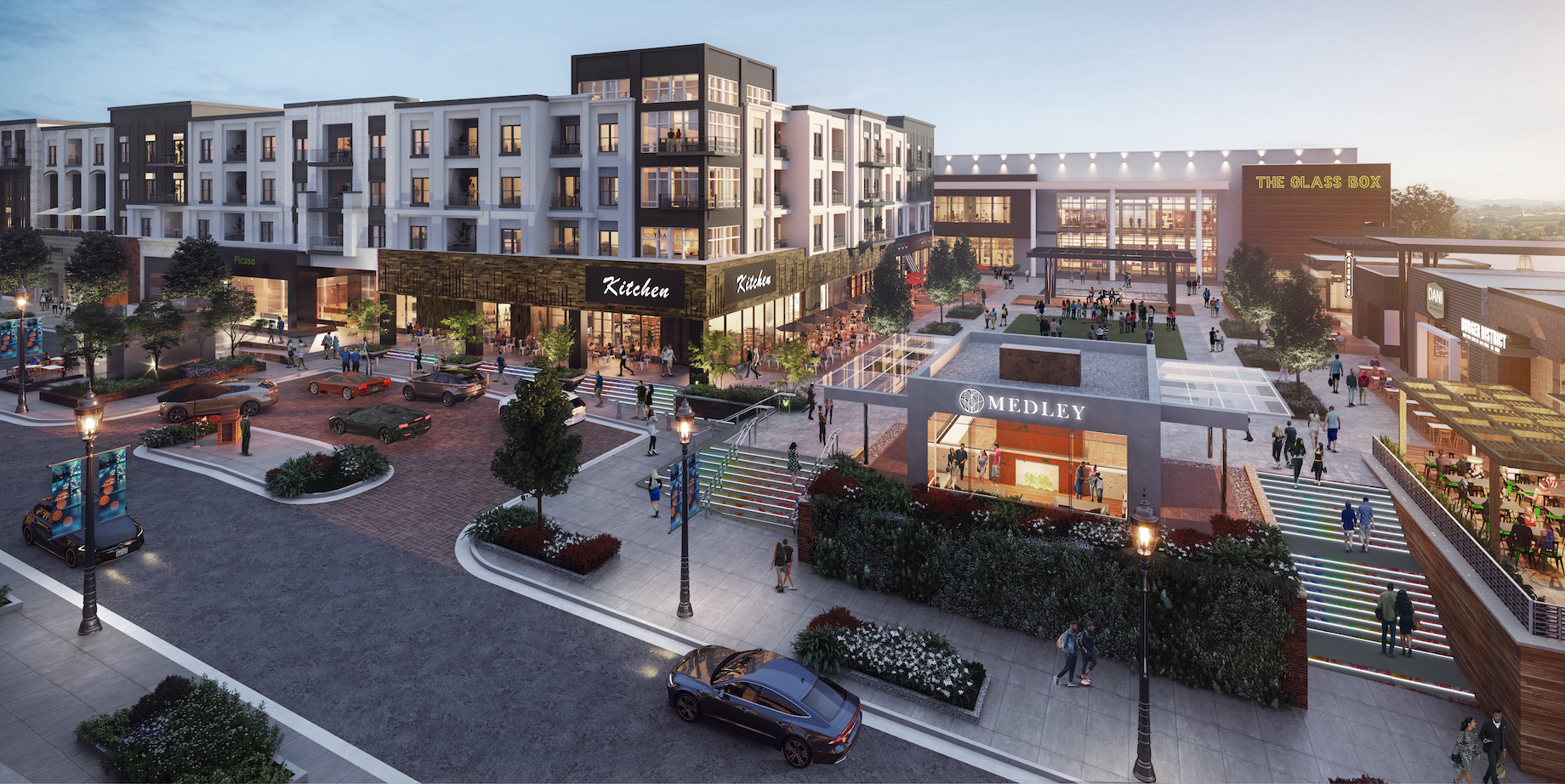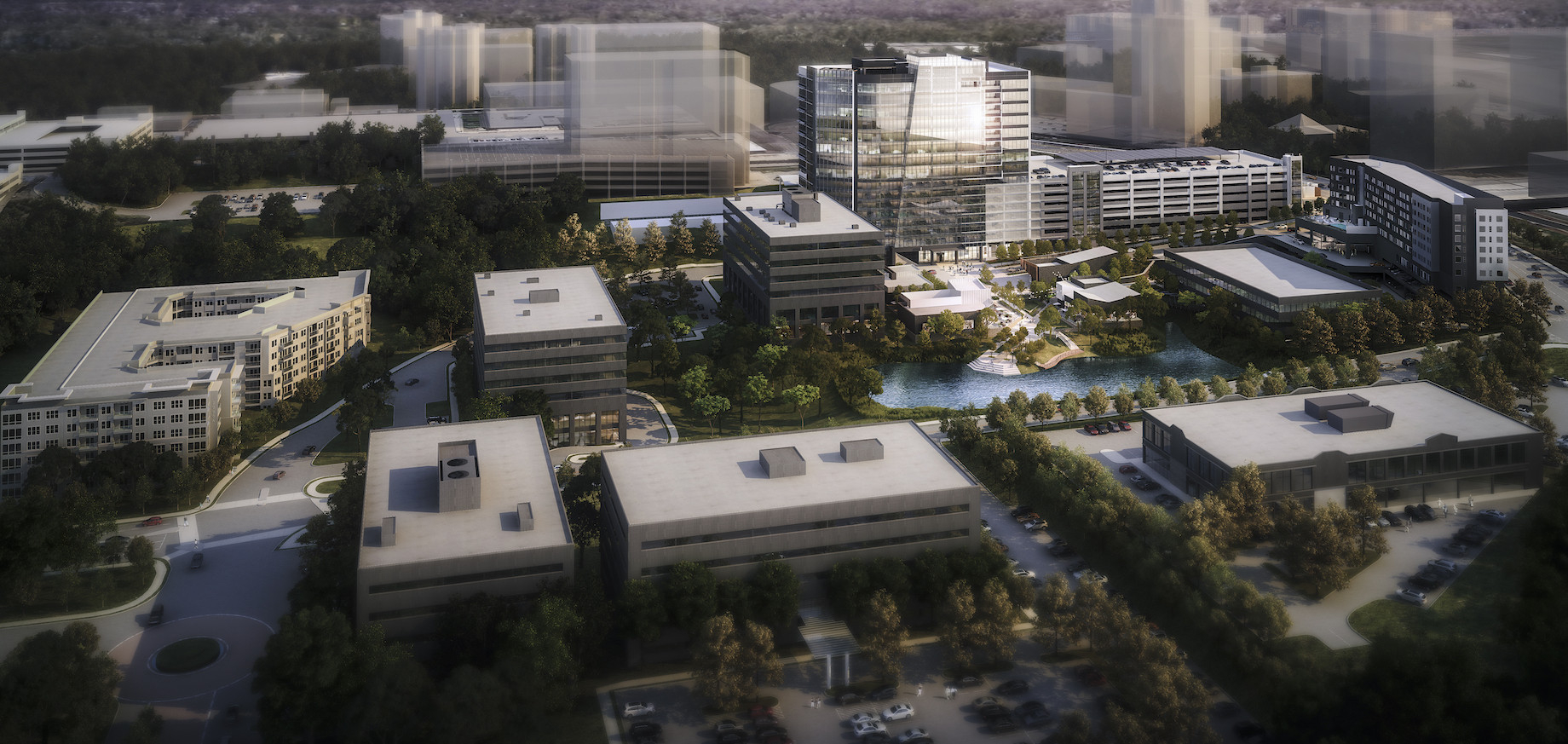Both owners and tenants need to confront the plummeting performances of older suburban office buildings surrounded by acres of asphalt, said Toro Development founder Mark Toro. “The misery in what I will call the ‘boring office sector’ is just beginning,” he said. “If you’re in a suburban office park and you step outside your front door and are standing in a surface parking lot, you’re dead.”
It’s why interest runs high in transforming suburban offices into mixed-use or multifamily developments. Cooper Carry principal Steve Smith has seen the groundswell firsthand. “We have just been inundated by people calling us from around the country trying to look at what can be done with different office buildings, quite often from an adaptive-reuse standpoint,” the architect said.
On a recent bus tour of real estate in the Washington, D.C., suburbs, Smith drove past one distressed office project after another. “I call it a ‘fried egg,’ an office building in the middle of a sea of parking,” he said. “Lots of them are just sitting empty.” In suburban Maryland, 19.3% of office space was “directly available” in the second quarter, according to a report by Avison Young. That figure includes vacancy, as well as space that will become vacant — for example, offices occupied by tenants that plan not to renew their leases. That’s up from 15.8% at the end of the second quarter of 2020.
“Availability in office buildings continues to rise, likely due to various companies, whether they are based in suburban Maryland or elsewhere, shrinking their office portfolio,” Avison Young noted. Total office space in the market “is decreasing due to a myriad of factors, most notably a rise in office-to-residential conversions.”
Office Tenants Want High Energy
Suburban office parks face the same macroeconomic headwinds as their urban counterparts. As summed up in Cushman & Wakefield’s Q2 2023 U.S. Office Marketbeat report, those headwinds include slowing GDP and job growth, particularly among office workers, as well as widespread jitters about a recession.
Additional findings in the report:
- net absorption was negative-26.9 million square feet, the lowest quarter in two years
- leasing dropped 24% year over year
- overall vacancy jumped 70 basis points from the first quarter to 19.2%
While downtown office districts are suffering from declines in traffic and occupancy, those suburban “fried eggs” have fallen out of favor due to disadvantages of their own, especially their lackluster tenant experience, parodied by the likes of the sitcom The Office and the 1999 film Office Space.
Employers still struggle to get people off Zoom and back at their desks. Because forcing the issue can backfire, many continue to allow two or three days a week of working from home. As a result, office lessees might find that just a handful of employees are on the floor at any time.
Subleasing underused square footage could be an option. But according to Cushman & Wakefield, the trend appears to be hitting its limits. Office occupiers, the authors noted, have put 47.2 million square feet of vacant sublease space on the market in the past year. “Sublease availabilities now account for 2.9% of total inventory, nearly triple the pre-pandemic norm of approximately 1%. … There is currently 159 million square feet of available sublease space on the market, the most on record since Cushman & Wakefield began tracking this data in 2000.”
Meanwhile, other occupiers simply are letting their leases expire to consolidate office leaseholds and slash occupancy costs. As they do so, they’re more likely to ditch old-school offices and relocate to high-energy, mixed-use environments that can bolster recruitment and retention and draw workers back to the office, said Toro, who’s known for his mixed-use work in Metro Atlanta. That includes repositioning Atlantic Station, redeveloping Colony Square and developing Alpharetta’s $1 billion Avalon. Part of the appeal of mixed-use is the prospect of social and business encounters with people from other companies, industries and walks of life. “We no longer have a situation where the only community you have at your workplace is your workmates and your company,” he said.
As employers relocate, many are leasing in new, open, light-filled offices with amenities like relaxation areas, gaming rooms and natural outdoor spaces. According to Cushman & Wakefield, the highest-quality office buildings — generally less than a decade old with abundant services and amenities — “continue to strongly outperform the broader market. … Vacancy for these assets is more than 500 basis points below the overall average, and asking rents are 34% higher.”
However, even some of these improved office-only developments fall short compared to mixed-use environments with streetscapes, open lawns, cafe seating and programmed events. “I have seen some highly amenitized office spaces that are still not getting the folks back,” Smith said.
Office to Mixed-Use
In May, Toro traveled to the Atlanta suburb of Johns Creek to photograph the demolition, pictured at top, of a State Farm office campus vacated five years ago as part of the insurance giant’s office-consolidation plans. Toro Development is set to start construction there on a mixed-use replacement called Medley.

Toro Development’s plans for Medley, which will replace a vacant State Farm office campus, call for 200,000 square feet retail, restaurants and entertainment; 900 residential units, including townhomes and luxury multifamily apartments; and 110,000 square feet of office.
Suburban communities sometimes balk at higher-density projects, but Toro said his prior projects and his plans for a new “third-place” destination made an impression on the city of Johns Creek. Located about 30 miles northeast of downtown Atlanta, the suburban community aims to add 192 acres of public pathways and parks, as well as new commercial and residential real estate, as part of a town center plan. “Johns Creek had been averse to multifamily residential since the city’s inception in 2007,” Toro said, “but here, they acknowledged the need for feet on the street. You have to have density on the site so that those retailers and restaurateurs are supported day in and day out by the people who just ride the elevator to get to them, as opposed to getting in the car.”
In May, Toro Development announced the first 11 retail and restaurant concepts to lease space at Medley. They include chef-driven and new-to-market concepts like Ford Fry’s Little Rey, Cru Food & Wine Bar and AYA Medical Spa, as well as Sugarcoat Beauty, Knuckies Hoagies, Cookie Fix and Summit Coffee.
Office to Residential
While some densify old-office sites via mixed-use, other municipalities aim to mitigate the housing crisis by retrofitting empty or soon-to-be-empty office buildings into apartments or condos. This priority “has shot to the top of the charts in many of these jurisdictions,” Smith said. “They’re saying: ‘How could we make funds available? Can we help with the zoning code?’ They’re looking at things differently to speed these kinds of projects along.”
MORE FROM C+CT
Mammoth Mall Makeovers Answer the Housing Crisis
11 Things Developers Wish Economic Development Officials Knew
11 Things Economic Developers Wish Developers Knew
Not every suburban office is suitable for a cost-effective retrofit, the architect cautioned. The wrong footprint depth or column grid could translate into a budget-buster, as could the need to bring an old structure up to new building codes.
However, suburban properties offer some advantages to those who would retrofit them. For starters, Smith explained, many were built in the ’80s, after the U.S. asbestos ban. By contrast, buyers of World War II-era offices in big cities can discover lots of asbestos, including in unexpected places like masonry mortar, that must be remediated at high cost.
Suburban office buildings from the past 20 years are also more likely to be column free. “Why is that important? Because you have a lot more flexibility,” Smith explained. “You can reuse more of that existing footprint without having to encounter the extra cost.” In addition to greater compliance with modern building codes, some suburban offices boast taller between-floor spaces. The higher ceilings can be appealing to future residents of a multifamily conversion. “It creates a nicer user experience,” Smith said.
Location Is Everything
Would-be redevelopers also need to consider the strength of the surrounding trade area. The median household income around Medley, for example, is $134,000, nearly twice the $70,000 national average per Census data. That math favors Toro’s redevelopment project, but redevelopers should ask themselves, he said: “If that original office building were not there and you had the opportunity to build 200,000 square feet of retail and entertainment, would it be supported by the community around it?”
Here, too, suburban office sites offer advantages. In many cases, they were built when land values and population densities were much lower. Strong growth over the years, including the suburban flight that occurred during the pandemic, can make these sites solid targets for cost-effective densification, such as adding hotel, apartments, retail and inviting public spaces, Smith said.
Cooper Carry is in design on several densification projects involving suburban office and retail properties, he said. Designed on behalf of The Simpson Organization, Altmore is a mixed-use redevelopment of a 20-acre Atlanta office park that Cooper Carry designed in the late ’70s.

Cooper Carry designed a 20-acre Atlanta office park in the late ’70s and now is designing its redevelopment into mixed-use.
Located in a first-ring suburb, the site offers easy access to the MARTA transit Medical Center station. Details of the three-phased densification plan include:
- a six-level parking deck with approximately 700 spaces and a cast-in-place concrete horizontal expansion for future offices
- a nine-story, high-end Hyatt House extended-stay hotel on what was once surface parking
- a four-building restaurant village fronting Lake Hearn where a two-story office building used to stand
- an urban plaza
- an eight-story office building
- a multifamily project designed by Dwell and Cooper Carry’s multifamily studio
- an interior road with a multiuse trail
Need for Realistic Asking Prices
In a study published in April, Avison Young reported that as many as 34% of office buildings in 14 major North American markets could be candidates for adaptive reuse. “Looking at more than 26,000 buildings, office-to-residential conversions could open the door to potential housing for thousands of families in as many as 8,996 properties,” the firm noted.
But before residential conversions of lagging suburban office buildings truly can take off, some owners will need to be more realistic about these properties’ asking prices and prospects, according to Smith. “At some point, they’re going to have to let go of these buildings and realize that they are not coming back to their former glory in terms of rents and returns.”
Redevelopers also need to be disciplined about the targets they pursue. “The pro forma has got to work,” Smith said. “It might be a good candidate for an adaptive reuse with bigger volumes and ceilings, column-free spaces and large windows, but if you cannot get it for the right price, just move on to the next deal.”
By Joel Groover
Contributor, Commerce + Communities Today